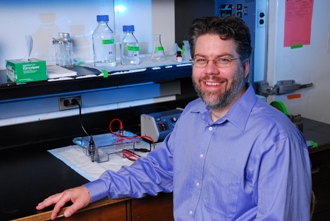
Dr. Scot Stone BSc, PhD
Professor Biochemistry, Microbiology & Immunology- Address
- Room 2D30.5 Health Sciences
Research Area(s)
- Acyltransferase, Triglyceride, Lipid droplet, Obesity, Diabetes
About
B.Sc. University of Saskatchewan, 1993, Department of Physiology
The goal of my research program is to understand how DGAT2 functions in cells to synthesize triacylglycerol. Triacylglycerols are the major storage form of energy in eukaryotic organisms. However, excessive accumulation of triacylglycerols in adipose tissue results in obesity, which has now reached epidemic proportions in Canada. In addition, excessive levels of triacylglycerols in non-adipose tissues, such as skeletal muscle, liver, heart, and pancreatic beta cells are associated with insulin resistance and can lead to type 2 diabetes mellitus, while elevated plasma triacylglycerol levels are associated with cardiovascular disease.
In mammals, triacylglycerols are synthesized in a reaction catalyzed by acyl CoA:diacylglycerol acyltransferase (DGAT) enzymes (DGAT1 and DGAT2) and are stored primarily in white adipose tissue in cytosolic lipid droplets. DGAT2 is present in the endoplasmic reticulum, but also interacts with lipid droplets where it catalyzes triacylglycerol synthesis for lipid droplet expansion.
Our studies are designed to address fundamental questions in triacylglycerol metabolism and provide new insights into the molecular mechanisms responsible for triacylglycerol synthesis and storage. In the long term, this knowledge may be of clinical significance with respect to the development of therapies for the treatment or prevention of obesity and cardiovascular disease.
Recent Publications
- Brandt C, McFie P, Vu H, Chumala P, Katselis G, Stone S. Identification of calnexin as a diacylglycerol acyltransferase-2 interacting protein. PLOSone. 2019 Jan 7;14. https://journals.plos.org/plosone/article?id=10.1371/journal.pone.0210396
- McFie P, Banman L, Stone S. Diacylglycerol acyltransferase-2 contains a c-terminal sequence that interacts with lipid droplets. BBA – Molecular and Cell Biology of Lipids. 2018 Jun 9;1863:1068-1081. Comment: Journal impact factor 5.547
- McFie P, Ambilwade P, Vu H, Stone S. Endoplasmic reticulum-mitochondrial interaction mediated by mitofusin-1 or mitofusin-2 is not required for lipid droplet formation or adipocyte differentiation. Biochem Biophys Res Commun. 2016 Jul 7;478:392-397.
- McFie P, Izzard S, Vu H, Jin Y, Beauchamp E, Berthiaume L, Stone S. Membrane topology of monoacylglycerol acyltransferase-2 and identification of regions important for its localization to the endoplasmic reticulum. BBA – Molecular and Cell Biology of Lipids. 2016 Jun 29;1861(9):1192-1204.
- Brandt C, McFie P, Stone S. Diacylglycerol acyltransferase-2 and monoacylglycerol acyltransferase-2 are ubiquitinated proteins that are degraded by the 26S proteasome. Biochemical Journal. 2016 May 24;473:3621-3637.
- Brandt C, McFie P, Stone S. Biochemical characterization of human acyl coenzyme A: 2- monoacylglycerol acyltransferase-3 (MGAT3). Biochemical and Biophysical Research Communications. 2016 May 13;475:260-270.
- Hlynialuk, Ling, Cobine, Yu, Bolet, Wai, Hossain, El Zawily, McFie, Stone, Diaz, Moraes, Viswanathan, Petris, Leary. The Mitochondrial Metallochaperone SCO1 Is Required to Sustain Expression of the High- Affinity Copper Transporter CTR1 and Preserve Copper Homeostasis. Cell Reports. 2015 Feb 17;10(6):933- 943.
